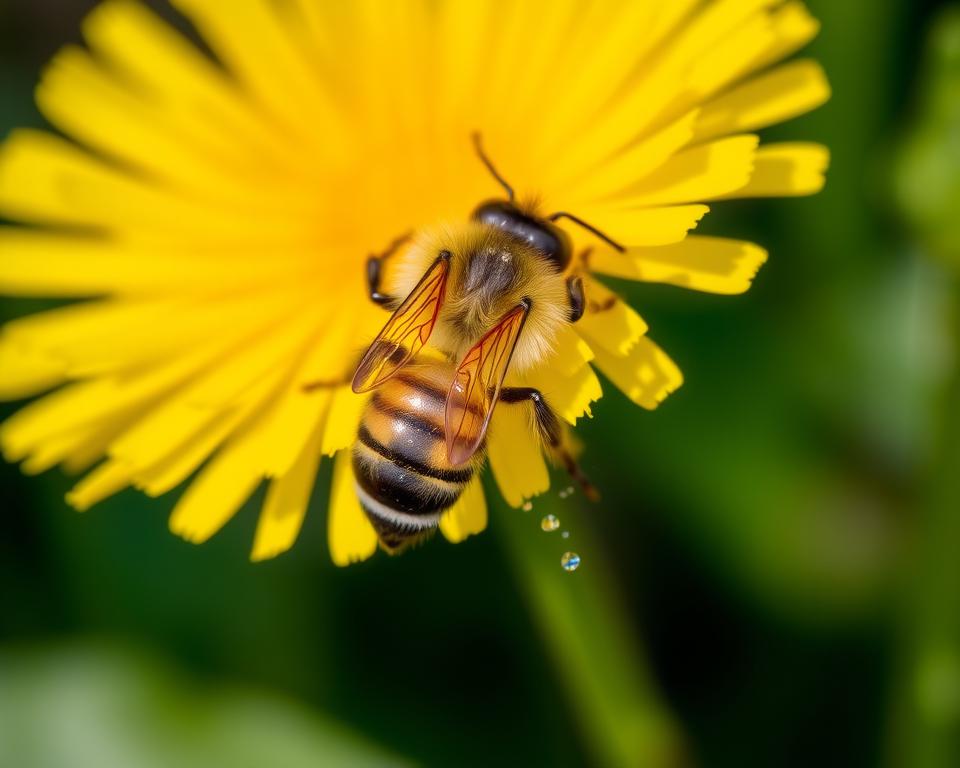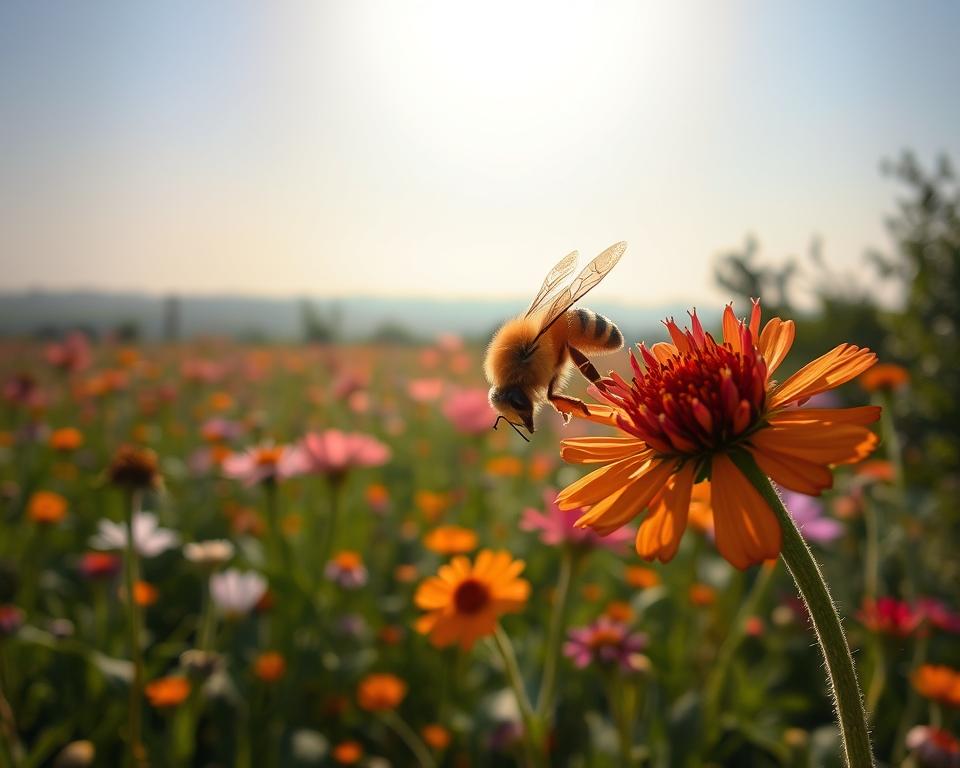I find the social structure of honey bees fascinating. They play a key pollination role in our ecosystem. Over 80% of the world’s crops depend on them for pollination.
Exploring their world shows their social hierarchy is complex. Each caste has its own duties. Learning about their roles helps us see how vital bees are for our planet’s health.
Key Takeaways
- The pollination role of bees is vital for global food production.
- Honey bees live in complex societies with distinct castes.
- Understanding their roles is key to appreciating their importance.
- Bee colonies are essential for maintaining ecological balance.
- The social structure of honey bees is fascinating and complex.
The Importance of Honey Bees in Our Ecosystem
Honey bees are vital to our ecosystem. They help with pollination and honey production. These tasks are key to our ecosystem’s health and bring economic benefits.
Honey bees are key in pollination. They move from flower to flower, spreading pollen. This helps many plants reproduce, including those that grow fruits, vegetables, and nuts.
Pollination: The Heart of Their Role
The pollination role of bees is vital for our food. Without them, many plants can’t reproduce. This would lead to less food and affect the economy.
Here’s a table showing some crops that need honey bees:
| Crop | Dependency on Honey Bees |
|---|---|
| Almonds | High |
| Apples | High |
| Blueberries | High |
| Pumpkins | Medium |
Honey Production and Its Economic Value
Honey bees also make honey. Honey is valuable worldwide, boosting the economy. Beekeepers keep bees for honey, taking it from the honeycombs.
Honey is valuable for food, cosmetics, and medicine. Its global demand keeps growing. This makes honey a key product in trade.
In summary, honey bees are essential for our ecosystem. They help with pollination and honey production. Their work is vital for our environment and economy, making their protection critical.
The Three Primary Roles of Honey Bees
Honey bees have a complex social structure with three main roles. These roles are key to the colony’s survival. Each bee has a vital part to play in the colony’s functioning.
Queen Bees: The Reproductive Powerhouse
The queen bee is the largest in the colony. She lays eggs and controls the colony’s social order with her pheromones. Her ability to lay up to 2,000 eggs daily is essential for the colony’s growth.
The queen’s role goes beyond reproduction. She also keeps the colony in harmony with her pheromones. This complex communication system helps all bees work together.
Worker Bees: The Busy Laborers
Worker bees are female and handle many tasks. They forage, care for young, and keep the hive in order. As they age, their roles change, with younger ones caring for brood and older ones foraging and guarding.
Their hard work is vital for the colony’s success. They gather food and water and keep the hive’s structure intact. Their flexibility ensures the colony’s needs are met.
Drones: The Unsung Contributors
Drones are male bees with a key role in the colony. They mate with the queen and contribute to the colony’s well-being. Unlike workers, drones do not gather food or defend the hive.
Despite their limited tasks, drones are critical for genetic diversity. They provide the genetic material needed for the queen’s reproduction. Their presence is essential to the colony’s social structure.
The Life Cycle of a Honey Bee
Honey bees go through a remarkable change from egg to adult. They play different roles in their colony. This process, called holometabolism, has four stages: egg, larva, pupa, and adult.
From Egg to Adult: A Fascinating Journey
The egg stage starts when the queen bee lays eggs in honeycomb cells. After 3-4 days, these eggs hatch into larvae. The larvae are fed royal jelly and bee bread by worker bees.
As the larvae grow, they molt several times. They then enter the pupal stage. In this stage, they transform into adult bees. This stage is key for Bee Larvae Development.
Roles Throughout Development
As honey bees grow, they take on different roles in the colony. Young worker bees start as nurse bees, caring for the larvae.
As they get older, they may become undertaker bees, removing dead bees. They can also be guard bees, protecting the hive entrance, or forager bees, collecting nectar and pollen.
| Life Stage | Duration | Key Characteristics |
|---|---|---|
| Egg | 3-4 days | Laid by the queen bee in honeycomb cells |
| Larva | 4-5 days | Fed royal jelly and bee bread by worker bees |
| Pupa | 7-10 days | Undergoes transformation into an adult bee |
| Adult | Varies | Assumes various roles based on age and needs |
In conclusion, the life cycle of a honey bee is complex and vital for the colony’s survival. Understanding these stages and roles shows the importance of each bee’s role in Bee Colony Organization.
How Worker Bees Contribute to the Colony
Worker bees are the backbone of the honey bee colony. They do many important jobs. These jobs help the colony survive and thrive.
Foraging and Gathering Resources
Worker bees go out to find nectar, pollen, and water. They collect these from flowers. This food is used to feed the colony and make honey.
The bee foraging behavior is very complex. Bees communicate through dance to tell others where food is.

Nest Maintenance and Hive Protection
Worker bees also take care of the hive. They build honeycombs from wax they make themselves. They fix any damage too.
They also protect the hive entrance. This keeps predators and intruders out.
Role in Caring for the Young
Worker bees play a key role in caring for the young. They feed and clean the larvae. They also keep the hive warm.
This care is vital for the young bees to grow. It ensures the colony’s future.
| Duty | Description | Importance |
|---|---|---|
| Foraging | Gathering nectar, pollen, and water | Feeds the colony and produces honey |
| Nest Maintenance | Constructing and repairing the hive | Ensures hive integrity and safety |
| Caring for the Young | Feeding and nurturing larvae | Crucial for colony’s future |
In summary, worker bees do many important jobs. Their tireless efforts in foraging, nest maintenance, and caring for the young are key. They are vital to the colony’s success.
The Unique Role of the Queen Bee
At the heart of every thriving honey bee colony is a queen bee. Her role is key to the colony’s growth and survival. She does this mainly through her ability to reproduce.
Reproduction and Survival of the Colony
The queen bee’s most important job is laying eggs. This is vital for the colony’s population and survival. A healthy queen can lay up to 2,000 eggs per day, keeping the colony alive.
For more info on the queen bee’s role, visit Perfect Bee.
Her pheromones also help control the colony’s social order. They tell worker bees that the queen is healthy and around. This chemical talk is key to keeping the colony running smoothly.
How She Communicates with Worker Bees
The queen bee talks to worker bees through pheromones. These chemical signals tell other bees about the queen’s health and status. They also tell worker bees what tasks to do.
For example, the queen’s pheromones can tell worker bees to get ready for swarming. Or to change their foraging plans. This shows how complex the beehive social structure is, with each member playing a big role.
In short, the queen bee’s role is not just about reproduction. It’s also about complex communication with worker bees. Her health and presence are essential for the colony’s success, making her a key figure in the honey bee colony’s social order.
Drones: Beyond Mating
Drones are more than just the male bees in the honey bee world. They are key to the colony’s social structure. Their role in mating is well-known, but their contributions to the colony’s harmony and organization are just as important.
Their Role in the Honey Bee Community
Drones are vital for the colony’s social balance. They are the male bees, and their presence is essential for the colony’s social cohesion. They don’t gather food or defend the hive, but their interactions with worker bees help keep the colony stable.
- They help in maintaining the colony’s social hierarchy.
- Their presence affects the behavior of worker bees.
- Drones contribute to the genetic diversity of the colony through mating.
What Happens to Drones in Winter
In winter, drones face a different fate. As the weather gets colder and resources are scarce, the colony’s priorities change. Worker bees often expel drones to save resources, as drones don’t help with foraging or maintaining the hive.
This change is key for the colony’s survival. It lets worker bees focus on keeping the queen and other colony members alive through winter. The decision to expel drones shows the complex social organization of honey bees, where the colony’s needs come first.
- Drones are expelled from the hive as resources dwindle.
- This expulsion is a strategy to conserve food and warmth.
- The colony’s survival is prioritized over the individual survival of drones.
In conclusion, drones are essential to the honey bee colony, contributing to its social structure and harmony. Understanding their roles and the challenges they face, like in winter, sheds light on the intricate organization of bee colonies.
The Communication of Honey Bees
Learning how honey bees talk is key to understanding their complex social lives. They share info on food, threats, and more. This sharing is vital for the colony’s survival and growth.
The Waggle Dance: A Language of Movement
Honey bees use the waggle dance to tell others about food. This dance is a figure-eight pattern that shows where food is, relative to the sun. By dancing, forager bees can recruit others to find food, making the colony more efficient.
The waggle dance is a unique way of symbolic communication in insects. It lets bees share complex spatial info. This dance is essential for Bee Foraging Behavior, helping the colony find and use food well.
Pheromones: Chemical Communicators
Honey bees also use pheromones to talk. These chemical signals tell about danger, reproductive status, and more. For example, alarm pheromones warn bees of threats, leading to defense. Pheromones are key in keeping the Beehive Social Structure in order.
Pheromones show the advanced chemical communication systems of honey bees. By studying these systems, we learn about the complex social life in the hive.
Environmental Challenges Facing Honey Bees
Environmental challenges like pesticide use and habitat loss are hurting honey bees a lot. The pollination role of bees is key for our ecosystem. Their decline could have big effects. It’s clear that their colony organization faces big threats.

Pesticides and Their Impact
Pesticides, like neonicotinoids, are a big problem for honey bees. They can mess with bees’ ability to find their way and talk to each other. This weakens the colony. It’s worrying that these pesticides harm honey bee health so much.
Pesticides don’t just poison bees; they also mess with their foraging behavior and reproductive capabilities. This can make the bee population drop. It also makes it harder for the colony to make it through the winter.
Habitat Loss: A Growing Concern
Habitat loss is another big problem for honey bees. The destruction of natural habitats cuts down on places for bees to forage and nest. Saving natural habitats is key to keeping honey bees healthy.
Without diverse plants, bees can’t get the food they need. This also hurts their pollination role. Keeping diverse ecosystems helps the complex social life of honey bee colonies and their colony organization.
Bee Conservation Efforts
Honey bee conservation is a big deal now. People and groups are working together to save these important pollinators. We know how vital honey bees are to our world, so we must all help keep them safe.
The drop in honey bee numbers is bad for our planet, economy, and food. We need to look at what’s being done to save them and how we can help.
Local Initiatives to Protect Honey Bees
In the U.S., towns are doing a lot to help honey bees. One key thing is making places friendly for bees. This means planting flowers that give bees food and water.
Local groups and governments are also backing beekeeping. They offer help and lessons for new beekeepers. This helps grow the number of healthy bee colonies.
| Initiative | Description | Impact |
|---|---|---|
| Bee-friendly Habitats | Planting flowers that provide nectar and pollen | Increased food sources for honey bees |
| Beekeeping Support | Education and resources for new beekeepers | Growth in the number of healthy bee colonies |
| Research and Monitoring | Studying bee health and habitats | Better understanding of bee decline and conservation strategies |
How Individuals Can Help
Everyone can help save honey bees. One easy way is to plant flowers that bees like in your garden or community areas. This helps bees and makes our places look nice.
Buying honey and other bee products from local beekeepers is another good thing to do. Also, using fewer pesticides in your garden helps keep bees safe from harmful chemicals.
Simple Actions for Bee Conservation:
- Plant bee-friendly flowers
- Support local beekeepers
- Reduce pesticide use
- Create bee habitats in your community
By doing these things, we can all help save honey bees. Every little bit helps, and together we can make a big difference.
The Future of Honey Bees and Agriculture
Honey bees play a vital role in our ecosystem. Their health is linked to the success of agriculture. Bees are essential for many plants to reproduce, thanks to their pollination role.
Science is key to solving the problems facing honey bees. By studying their behavior and social structure, we can protect them. Changes in farming, like using bee-friendly plants and reducing pesticides, also help.
Advancements in Sustainable Farming
New farming methods help keep bees healthy and support sustainable agriculture. Practices like crop rotation and organic farming improve soil and biodiversity. This benefits both bees and farmers.
As we look to the future, understanding bees’ social structure and pollination role is critical. This knowledge will help ensure the health of our ecosystems for years to come.
